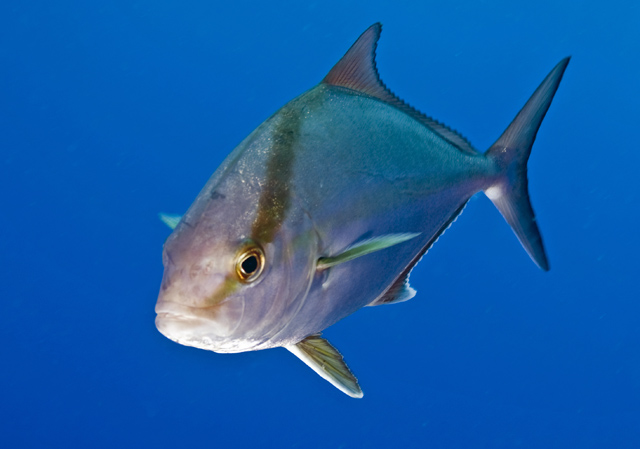- Classification
- ACTINOPTERYGII
- PERCIFORMES
- CARANGIDAE
- Seriola
- rivoliana
Highfin Amberjack, Seriola rivoliana Valenciennes 1833
Other Names: Almaco Jack, Longfin Yellowtail, Yellow Kingfish

A Highfin Amberjack, Seriola rivoliana, in Nelson Bay, New South Wales. Source: Dave Harasti / http://www.daveharasti.com/. License: All rights reserved
Summary:
A large jack with the anterior lobe of the second dorsal fin about twice as long or longer than the longest dorsal-fin spines, and longer than the pectoral fin.
The Highfin Amberjack is greenish to brownish above, becoming silvery below, sometimes with a brassy or lavender sheen, and a dusky stripe from the snout through the eye to the front of the dorsal fin (stripe becoming less distinct with age). Juveniles (to ~20 cm) also have 7 dark bars along the side and tail base that do not extend onto the bases of the dorsal and anal fins.
The Highfin Amberjack is greenish to brownish above, becoming silvery below, sometimes with a brassy or lavender sheen, and a dusky stripe from the snout through the eye to the front of the dorsal fin (stripe becoming less distinct with age). Juveniles (to ~20 cm) also have 7 dark bars along the side and tail base that do not extend onto the bases of the dorsal and anal fins.
Cite this page as:
Bray, D.J. 2019, Seriola rivoliana in Fishes of Australia, accessed 10 Jul 2025, https://fishesofaustralia.net.au/home/species/1663
Highfin Amberjack, Seriola rivoliana Valenciennes 1833
More Info
|
Distribution |
Found in Australia from the Northwest Shelf to Rowley Shoals and north of Ashmore Reef in the Timor Sea, and off Caloundra, Queensland, to off Jervis Bay, New South Wales; also at Lord Howe Island and Norfolk Island in the Tasman Sea. Elsewhere, the species is circumglobal in tropical and subtropical seas. The species is pelagic and epibenthic, usually in oceanic waters. Adults are rarely encountered inshore. |
|
Features |
Dorsal fin VII-VIII + I, 27-33 (anteriormost spines may be imbedded in skin in very large fish); Anal fin II + I, 18-22 (anterior two spines reduced or embedded in large fish); Gill rakers (excluding rudiments) 18-29. Body elongate, fusiform, relatively deep, compressed; upper head & body profile distinctly more convex that lower profile; snout long, pointed; mouth terminating beneath middle of eye; supramaxillary bone very wide at rear, with sharp angle at upper corner; anal-fin base much shorter than soft dorsal-fin base; anterior dorsal and anal-fin rays elevated, 2nd dorsal-fin lobe height 16-25% of fork length; pectoral fins short (less than head length); tail base slender, with dorsal and ventral grooves; caudal fin strongly forked; lateral line with slightly arched above pectoral fin. |
|
Feeding |
Feeds mostly on fishes. |
|
Species Citation |
Seriola rivoliana Valenciennes 1833, Hist. Nat. Poiss. 9: 207. Type locality: Greece. |
|
Author |
Bray, D.J. 2019 |
|
Resources |
Highfin Amberjack, Seriola rivoliana Valenciennes 1833
References
Allen, G.R. 1997. Marine Fishes of Tropical Australia and South-east Asia. Perth : Western Australian Museum 292 pp. 106 pls.
Allen, G.R., Hoese, D.F., Paxton, J.R., Randall, J.E., Russell, B.C., Starck, W.A., Talbot, F.H. & Whitley, G.P. 1976. Annotated checklist of the fishes of Lord Howe Island. Records of the Australian Museum 30(15): 365-454 figs 1-2
Allen, G.R. & Swainston, R. 1988. The Marine Fishes of North-Western Australia. A field guide for anglers and divers. Perth, WA : Western Australian Museum vi 201 pp., 70 pls.
Francis, M. 1993. Checklist of the coastal fishes of Lord Howe, Norfolk, and Kermadec Islands, southwest Pacific Ocean. Pacific Science 47(2): 136-170 figs 1-2
Gloerfelt-Tarp, T. & Kailola, P.J. 1984. Trawled Fishes of Southern Indonesia and Northwest Australia. Jakarta : Dir. Gen. Fish. (Indonesia), German Tech. Coop., Aust. Dev. Ass. Bur. 406 pp.
Grant, E.M. 2002. Guide to Fishes. Redcliffe : EM Grant Pty Ltd 880 pp.
Hutchins, J.B. & Swainston, R. 1986. Sea Fishes of Southern Australia. Complete field guide for anglers and divers. Perth : Swainston Publishing 180 pp.
Johnson, J.W. 2010. Fishes of the Moreton Bay Marine Park and adjacent continental shelf waters, Queensland, Australia. pp. 299-353 in Davie, P.J.F. & Phillips, J.A. Proceedings of the Thirteenth International Marine Biological Workshop, The Marine Fauna and Flora of Moreton Bay. Memoirs of the Queensland Museum 54(3)
Kuiter, R.H. 1993. Coastal Fishes of South-eastern Australia. Bathurst : Crawford House Press 437 pp.
Oxley, W.G., Ayling, A.M., Cheal, A.J. & Osborne, K. 2004. Marine surveys undertaken in the Elizabeth and Middleton Reefs Marine National Nature Reserve, December 2003. Townsville : Australian Institute of Marine Sciences 64 pp.
Paulin, C., Stewart, A., Roberts, C. & McMillan, P. 1989. New Zealand fish: a complete guide. National Museum of New Zealand Miscellaneous Series 19: 1-279.
Randall, J.E., Allen, G.R. & Steene, R. 1990. Fishes of the Great Barrier Reef and Coral Sea. Bathurst : Crawford House Press 507 pp. figs.
Randall, J.E., Allen, G.R. & Steene, R. 1997. Fishes of the Great Barrier Reef and Coral Sea. Bathurst : Crawford House Press 557 pp. figs.
Sainsbury, K.J., Kailola, P.J. & Leyland, G.G. 1985. Continental Shelf Fishes of Northern and North-Western Australia. Canberra : Fisheries Information Service 375 pp. figs & pls.
Smith-Vaniz, W.F. 1999. Family Carangidae. pp. 2659-2756 in Carpenter, K.E. & Niem, T.H. (eds). The Living Marine Resources of the Western Central Pacific. FAO Species Identification Guide for Fisheries Purposes. Rome : FAO Vol. 4 2069-2790 pp.
Smith-Vaniz, W.F., Curtis, M., Williams, J.T., Brown, J. & Pina Amargos, F. 2015. Seriola rivoliana. The IUCN Red List of Threatened Species 2015: e.T16507347A16510402. http://dx.doi.org/10.2305/IUCN.UK.2015-4.RLTS.T16507347A16510402.en. Downloaded on 16 April 2019.
Valenciennes, A. in Cuvier, G.L. & Valenciennes, A. 1833. Histoire Naturelle des Poissons. Paris : Levrault Vol. 9 512 pp. pls 246-279.








